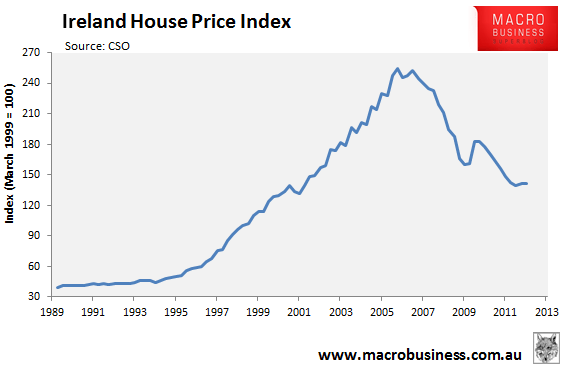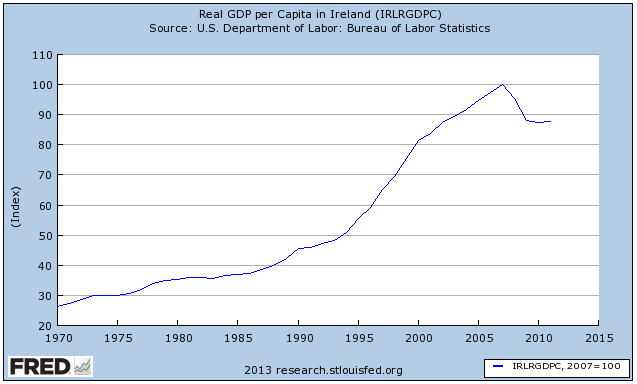
In 2004 Ireland was the toast of Europe and one of the world’s wealthiest countries:
“Ireland is one of the world’s wealthiest countries since its economy has grown nearly five-fold since 1973. It boasts one of the world’s highest levels of GDP per capita, some 20 percent above the European average—while 30 years ago it was 35 percent poorer than the average….
Ireland’s economic growth model has been hailed as an example of development done right, with everyone from professors in Pittsburgh to investment agencies in Armenia trying to figure out how to replicate the success of the Celtic Tiger.”
And in 2005, The Economist judged Ireland to have the best quality of life in the world.
How things change. Over the past six years, Ireland’s house prices have declined by around 50% (see next chart), wiping-out an estimated €257bn inequity, according to the Irish Independent newspaper, reportedly making Ireland’s property bust the biggest in history.
The 50pc collapse in value since the peak of 2007 also means that by the Central Bank’s own estimates, Ireland’s crash has now become the worst experienced by any country in the world.
The combined loss to the owners of Irish residential properties since the bubble burst equates to almost four times Ireland’s total bailout sum of €67.5bn and more than half the total amount of money first set aside in the European Union’s €500bn Financial Stability Facility…
An estimated drop of 50pc in value puts the average loss to an Irish household at €155,316.
With 1.6 million households across the country, that is a combined loss of more than €257bn…
However, if some critics of the Central Statistics Office (CSO) system are correct, then the average property capital value losses per household could be even higher…Conall Mac Coille, chief economist with Davy, recently claimed that Irish values could have already shed as much as 60pc. If this were true, then the average property has lost €186,379 in value, and the nationwide equivalent loss in property value is, in fact, €310bn.

Real GDP per capita in Ireland has also declined by around -12% since peak, with unemployment roughly tripling over the same period (see below charts).


A interesting aspect of the Ireland situation was that public finances were strong prior to the housing bust (see below IMF charts):

The problem for Ireland was that government finances had become too dependent on property taxes – both capital gains taxes and stamp duties. In 1997, Ireland’s government cut the capital gains tax rate from 40% to 20% and extended property tax concessions, which helped fuel property speculation. In 2007, stamp duty and capital taxes yielded €6.7 billion, but in 2010 they fell to only €1.6 billion (see below IMF chart).

Following the collapse of property taxes and the costly bail-out of its banks following the bursting of its housing bubble, Ireland’s net debt has exploded. In fact, the IMF had previously forecast that Ireland’s net debt would increase by around 50% of GDP over the period 2007 to 2015 (see below IMF chart).

As is the case with most housing bubbles, Ireland’s was fuelled by a number of inter-related drivers: easy credit, speculation, and unresponsive supply.
A 2010 article by Saul Eslake provides a nice explanation of how low interest rates and easy credit fuelled Ireland’s housing bubble:
“Once Ireland joined the euro at the beginning of 1999, short-term interest rates in Ireland were no longer set in Dublin in accordance with Irish conditions, but rather in Frankfurt in accordance with conditions in the euro zone.
Thus Irish short-term interest rates fell from about 6 per cent, where they had remained during the second half of the 1990s (which the Central Bank of Ireland had deemed appropriate for an economy that had been growing at rates of 8-11 per cent a year) to 3 per cent (which the European Central Bank considered appropriate for an economy that had been growing at about 2.5 per cent a year).
From then until the onset of the financial crisis, short-term interest rates averaged 3.25 per cent a year in Ireland, as they did in the euro zone, even though Ireland’s economy grew at an average annual rate of almost 6 per cent (compared with less than 2 per cent for the euro zone) and Irish inflation averaged 3.5 per cent a year (compared with 2.25 per cent a year for the euro zone).
Because Irish interest rates were substantially lower than they should have been for an economy growing as fast as Ireland’s was, Irish households and businesses borrowed (and Irish banks lent) far more than they would otherwise have done, resulting in (among other things) an unsustainable property boom in which Irish house prices more than doubled in less than seven years”.
Meanwhile, the Ireland Central Bank’s (ICB) 2007 Financial Stability Report explains the role played by investor speculation.
First, lending restrictions on investor mortgages were relaxed in the mid-1990s, which enabled property investors to borrow at the same interest rate and on similar terms to owner-occupiers. This led to a surge of property investment, as shown by the below ICB chart.

In fact, as at June 2007, investors accounted for around 27% of total mortgage lending – slightly below Australian investor’s share of 32% of total mortgage lending.
And the sharp rise in property prices prior to the global financial crisis (GFC) forced rental yields down:

As such, recent investors were cash flow negative in 2007, since rental income nowhere near covered holding costs:

So just as property investors in Australia rely predominantly on capital appreciation to make ends meet, investors in Ireland were doing the same.
However, once property prices began to fall, Ireland’s over-geared investors rushed for the exits, thus helping to force house prices down. The risk of investors fleeing the property market en masse was acknowledged by the ICB in 2007 just prior to the crash:
“…buy-to-let landlords, acting as dispassionate investors rather than emotionally involved owner occupiers, might decide more quickly than owner occupiers to dispose of properties in the event of a house-price fall, and this could potentially destabilise the wider housing market. The concern is a mass exodus of investors at the same time would put additional pressure on an already fragile market, causing a quicker downward spiral than would have otherwise been the case.”
Still, in true central bank fashion, the ICB rejected the notion that Ireland would experience a sharp housing correction, instead predicting a soft landing due to strong underlying fundamentals:
“Regarding future house price developments, factors that will have an influence on the future direction of house prices are investors’ participation in the property market, the sustainability of current rates of immigration and the future direction of monetary policy. The underlying fundamentals of the residential market continue to appear strong, as evidenced by rent increases. The central scenario is, therefore, for a soft, rather than a hard, landing.”
Ireland’s planning system also contributed to the initial boom and then bust of house prices by creating a system of supply that was unresponsive to market demand. A 2005 paper by the UK’s Policy Exchange explained the Irish supply situation well, whereby the Government granted planning permits too late, resulting in the building of large numbers of standardised, small, poor quality homes in satellite locations far away from the major cities:
According to Dr Stevenson of UCD Dublin, development for new housing actually took off much too late. “In the early years of the boom, we did not see much building in Ireland”… Because supply was late to meet demand, by the time construction activity actually took off it was too late to deal with the backlog in a reasonable way. All that planners and developers could do was try to satisfy the huge pent-up demand quickly. The result was a quick fix, not a thoroughly reasoned solution…
First, large numbers of flats – something the Irish were not used to – went up, in the form of large apartment-blocks. Second, whole new housing colonies were built, often consisting of hundreds of virtually identical semi-detached or terraced houses lacking any individual character. However, these were often far away from existing amenities, hardly provided any amenities themselves, were poorly built, and served as dormitory towns for existing cities (mainly Dublin). They were also much smaller than comparable houses built twenty or thirty years ago…
To sum up, in the words of Dr Brendan Williams: “The quantity of our supply is very, very good. The quality leaves a lot to be desired”…
Much of the hasty development that Ireland has seen over the past few years could have been avoided if supply had reacted earlier and in a more flexible way to rising demand. But in the early years of the boom, central government had still not realised how important it was to encourage housing development, and local councils, left alone without an independent tax base and lacking the incentives as well as the means to engage in proactive planning, did not plan for enough new houses.
Then, when it was almost too late and prices had already skyrocketed, the government realised the dangers of this situation and encouraged building. But, as Ronan O’Driscoll put it, “the government only thinks in numbers and units” – thus failing to understand that good, flexible and strong supply means more than just “throwing in a few hundred two-storey, three bedrooms semis” (Liam O’Donnell). And this “thinking in numbers” was passed down from central government to local planners, who could basically declare that they had done their jobs properly if they could only show that their numbers had gone up. The quality of these developments does not appear in the statistics and is hard to quantify anyway.
In a nutshell, Ireland’s planning system was ineffective in mitigating price rises through easy credit and speculation, since the new housing was predominantly built too late in the process and only where they were permitted, rather than where the market demand was. The end result is a large number of empty estates of unwanted housing in remote locations far from amenities or employment, huge developer and bank losses, and an economy now in tatters.

